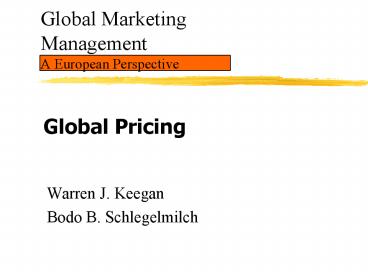Global Marketing Management A European Perspective - PowerPoint PPT Presentation
Title:
Global Marketing Management A European Perspective
Description:
Global Marketing Management A European Perspective Global Pricing Warren J. Keegan Bodo B. Schlegelmilch Overview Environmental Influences on Pricing Decisions ... – PowerPoint PPT presentation
Number of Views:76
Avg rating:3.0/5.0
Title: Global Marketing Management A European Perspective
1
Global MarketingManagementA European Perspective
Global Pricing
- Warren J. Keegan
- Bodo B. Schlegelmilch
2
Overview
- Environmental Influences on Pricing Decisions
- Different Approaches to International Price
Setting - Standardisation vs. Differentiation
- Dumping
- Grey Markets and Parallel Imports
- Transfer Pricing
- Summary
3
Learning Objectives
- Know about the complexity of international price
setting - Appreciate which external and internal factors
influence international pricing - Learn about different approaches to setting
prices - Be aware of factors promoting or inhibiting
international price standardisation - Know how to react to dumping by competitors
- Learn which key issues are involved in transfer
pricing
4
Global Pricing Important Concepts
- Rigid Cost-Plus Pricing and Flexible Cost-Plus
Pricing - Dynamic Incremental Pricing
- Price Corridor
- Dumping
- Parallel Imports and Grey Markets
- Transfer Pricing
- Principle of Arms Length
5
Environmental Influences on Pricing Decisions (1)
- Currency Fluctuations
- Two positions
- Fix prices in country target markets
- Fix prices in home-country currency
- Pricing should be consistent with the companys
marketing strategy - Inflation
- Inflation is a persistent upward change in price
levels - Inflation requires periodic price adjustments
6
Environmental Influences on Pricing Decisions (2)
- Government Controls and Subsidies
- In countries, which are undergoing severe
financial difficulties, governments may restrict
price increases or prescribe fixed prices - Competitive Behaviour and Market Demand
- Pricing decisions are also dependent on the
nature of demand and competitive action
7
Rigid Cost-Plus Pricing
- Adding up all the costs required to get the
product to where it is sold - All costs incurred in getting a product to an
international market are taken into account - Cost-Plus Pricing sometimes ignores competitive
conditions - Rigid cost-plus pricing is mostly used by
companies new to foreign business
8
Flexible Cost-Plus Pricing
- Flexible cost-plus pricing is based on the same
principle as rigid-cost plus pricing - However Prices may vary, if the market situation
requires (e.g. the nature of the customer, the
size of the order or the intensity of local
competition)
9
Dynamic Incremental Pricing
- Price setting practice which is based on the idea
that fixed costs occur regardless of whether the
company is successful or not - The goal is to regain at least variable costs and
international marketing and promotion costs in
export ventures - This strategy is also known as penetration
pricing - Penetration pricing means that the product may be
sold at a loss for a certain time to gain market
share
10
Standardisation vs. Differentiation in
International Pricing
- It is an important question whether prices should
be standardised across markets or differentiated
between international markets - Companies do not act consistently
- Cross-subsidisation a company uses financial
resources from one area to compete in another
area
11
Influences on Prices Standardisation vs.
Differentiation
Factors Driving
Factors Driving
Price Differentiation
Price Standardisation
Reduction
of
Trade
Customer
Preferences
Barriers
Related Drivers
Drivers
Competitive
Decreasing
Situation
Transportation
Costs
-
External
Market
Optimal
Prices
!
Active
Retailers
/
Grey
Cost
Situation
Markets
/Global
Sourcing
Price
Nivellation
?
Future
Developments
Improved
Communication
Inflation/Exchange Rates
Drivers
and
Information
Flow
Related
Increasing
Brand
External
Regulations
/
-
Drivers
Globalisation
/
Tariffs
and
Duties
Standardisation
Company
12
An International Price Corridor
13
Decision Making Framework for International
Pricing
14
Dumping
- A company exports a product at a price lower than
the price it normally charges in its own home
market - Dumping is an important global pricing issue,
because it is sometimes regarded as unfair
competition - Organisations like the WTO or OECD have issued
guidelines how to treat these problematic
situations
15
Grey Markets and Parallel Imports
- Distribution of trademarked products in a country
through channels unauthorised by the trademark
owner - Grey marketers take advantage of price
differences between markets by re-importing
branded merchandise from low-price to high-price
markets - Parallel Imports reduce or cannibalise sales by
authorised channel members in high-price countries
16
Transfer Pricing
- Pricing transactions between buyers and sellers
that belong to the same corporation - The approach used will vary with the nature of
the firm - Cost-Based Transfer Pricing
- Market-Based Transfer Pricing
- Negotiated Transfer Pricing
17
Tax Regulations and Transfer Prices
- Companies sometimes use transfer prices to shift
profits from high-tax to low-tax countries - The principle of arms length is a way of
establishing a transfer price between company
units. The price shall amount to what two
independent, unrelated entities would negotiate
18
Summary
- There are three different approaches to price
setting - Rigid-cost pricing
- Flexible-cost pricing
- Dynamic incremental pricing
- Dumping refers to selling products in
international markets at prices below those in
the home country - Grey Markets
- Transfer Pricing































